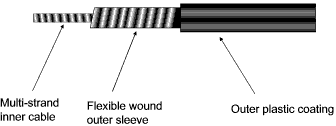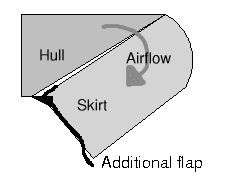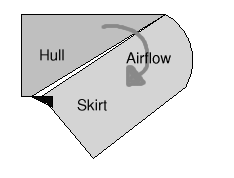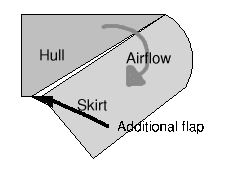Glossary.
In this section I'll attempt to explain the various terms used on the rest of this site.
If you find any terms misleading or poorly explained, please drop me a line.
- Bag skirt.
- A simple skirt consisting of a bag extending around the edge of the hull.
- Bowden cable.

Typically used for throttle or brake cables, bowden cables have a flexible steel stranded cable, surrounded by an outer flexible sleeve. the outer sleeve is fixed at each end, allowing the inner to be pulled. A bowden cable can only be used to pull and so some kind of spring return must be used. See Morse cable.
- Chip bag.

A chip bag is a variation on the standard open segment. This time the modification is to improve the segments performance at the rear of the craft. An extra flap of fabric is sewn into the segment to prevent water rushing in when the craft is not on full cushion over water.
- Kill switch.
- The kill switch is part of the ignition circuit. It has two contacts held apart by a small clip attached to the lanyard. In order for the engine to run, the Lanyard must be in place. If it is removed, the kill switch will close, killing the spark and stopping the engine.
- Lanyard.
- A lanyard on a hovercraft is a piece of rope or similar, worn around the wrist of the driver and connected to the kill switch. If the driver is thrown from the craft, the lanyard will pull free from the kill switch, stopping the engine.
- Morse cable.
- A Morse cable is similar in construction to a bowden cable but can also be used to push. It achieves this by using a sleeve at the end of the cable to contain the flexible inner and a steel rod transmits the movement.
- Open segment.

An open segment is the most basic of the skirt segments. Usually made from a single piece of fabric, the bottom edge is completely open. Compare this to a chip bag or pressure segment, both of which have additional pieces of fabric to control the air flow.
- Plough-in.
- A craft is said to "plough-in" when the skirt segments (usually at the front of the craft) collaps on water. This is more likely to happen when travelling down wind. As the front of the craft is pushed down by the following wind, the skirt segments are pushed down into the water and drag increases. This in turn pulls on the segments slowing them down and forcing the air out of them. Friction increases and the craft can slow down dramatically, often resulting in the driver being thrown out. Integrated craft are more likely to suffer than those with a lift fan.
- Pressure Segment.

A pressure segment is similar in design to a basic open segment but with an extra piece of fabric inside. The idea is that when the segment starts to collapse, either due to a plough-in or because of some obstacle, the front of the segment closes in on the flap inside and keeps the air in, preventing the segment from deflating completely.
- Segmented skirt.
- Skirts of this type are made up of series of individual cushion segments. Usually between 54 and 60 will be used. These are fixed to the hull at the top and bottom. Three main types of segment are used; open, pressure and chip bags.
- Skirt.
- The skirt is fixed around and below the hovercraft. It provides a flexible interface between the craft and the ground, conforming to the surface whilst keeping the air cushion inside. There are two main types of skirt used in racing hovercraft, the segmented skirt and the bag skirt.